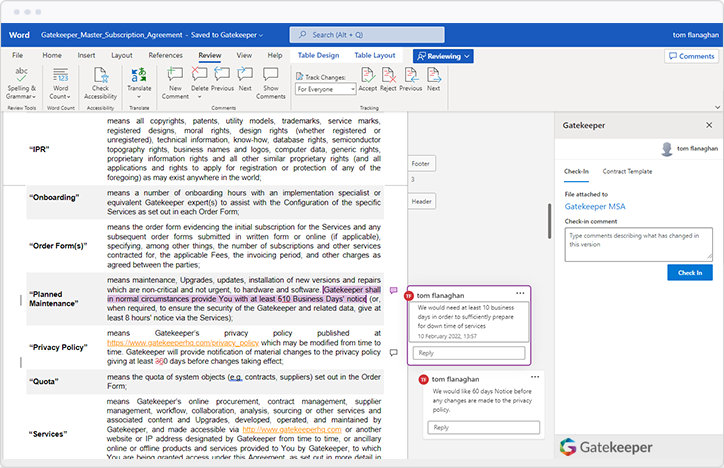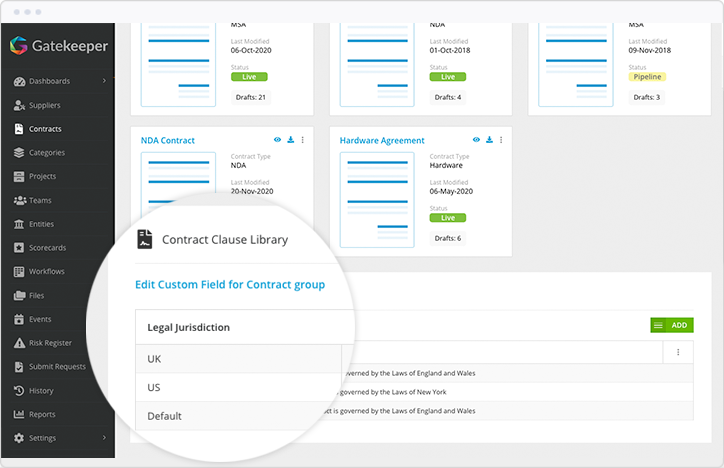Choosing The Best Contract Redlining Solutions to Future-Proof Your Legal Operations
9:23
Contract Redlining, Contract Management Software, Contract Negotiation, Redlining solutions, Microsoft Word, Redlining
Shannon SmithMar 24, 2025 2:00:00 PM
Contract redlining - the process of reviewing, editing, and negotiating agreements - has long been a bottleneck, requiring extensive manual oversight to track changes, assess risks, and maintain policy alignment.
With rising contract volumes and increasing demands for speed, manual redlining is no longer sustainable. AI-driven contract redlining software is now essential, offering structured automation that accelerates contract negotiations, reduces errors, and minimises risk exposure.
Without it, legal teams risk falling behind, burdened by inefficiencies that stall business agility and increase compliance risks.
The legal profession has traditionally relied on manual contract review processes that are time-consuming, resource-intensive, and error-prone.
In highly regulated industries, where compliance is paramount, the risks associated with inefficient redlining processes are amplified. Legal teams find themselves trapped in a cycle of reactive work, drowning in a backlog of contract reviews while struggling to enforce policy adherence at scale.
According to EY Legal:
Without contract redlining software, legal professionals face several core challenges:
The inefficiencies of manual contract redlining are more than just an inconvenience—they have tangible business costs.
Organisations that embrace redlining automation gain:
Contract redlining software eliminates many of the inefficiencies associated with traditional contract negotiation processes. By combining automation with a centralised repository and intelligent workflows, legal teams can shift their focus from repetitive, manual tasks to high-value advisory work.
The best contract redlining solutions provide a seamless experience for legal teams by integrating with existing workflows and AI, and offering comprehensive compatibility with commonly used document processing tools. Key features include:
A native Microsoft Word-compatible redlining solution that allows legal teams to work within their preferred document editor is a must. Whether working on vendor-supplied contracts or internal templates, teams can negotiate and redline contracts without disrupting their existing workflows.
This eliminates the need for clunky workarounds, file conversions, or version mismatches, ensuring that contract negotiations proceed smoothly without delays or confusion.

With seamless integration into Office for the Web and Google Docs, redlining software enables real-time collaboration without the need for document downloads or multiple conflicting versions.
By allowing legal teams to work in environments they are already familiar with, whether Microsoft Word, Google Docs, or Office for the Web, dedicated software removes the learning curve associated with adopting new tools.
Legal professionals can redline contracts within platforms they trust and use daily, enhancing usability and efficiency. This flexibility ensures that teams can focus on strategic contract negotiations rather than struggling with unfamiliar software, ultimately accelerating contract turnaround times and improving legal productivity.

Contract redlining software enables legal, procurement, and vendor management teams to significantly reduce the manual effort involved in contract reviews - cutting negotiation times by up to 85%. This efficiency allows teams to prioritise critical activities such as post-signature contract oversight, ongoing performance management, and proactive risk mitigation.
AI-driven contract review, supported by lawyer-approved playbooks and advanced risk detection capabilities, empowers non-legal stakeholders to confidently manage contract revisions and compliance without frequent legal intervention.
This reduces bottlenecks, enabling legal professionals to concentrate their expertise on strategic advisory, governance, and broader organisational risk management.-4.png?width=1000&height=498&name=image%20(11)-4.png)
Contract redlining software, such as eNegotiate, enables legal teams to generate unlimited contract templates with a single click. By dynamically inserting relevant data from contract records, teams can create fully pre-populated agreements without manual entry errors.
Access to a Clause Library allows organisations to automate contract generation using pre-approved, compliant legal language. This ensures that all contracts adhere to company policies while reducing the workload on legal teams by providing instant access to approved clauses.

By providing a unified platform for legal, procurement, and vendor stakeholders, redlining tools centralise all contract edits, comments, and approvals in one place. This eliminates the back-and-forth of email-driven negotiations and ensures that all teams are aligned throughout the contract process.
Stakeholders can suggest changes, track revisions, and approve contracts in real-time, reducing the friction associated with lengthy negotiations. This improves efficiency while maintaining full visibility over contract edits and decision-making processes.
One of the major bottlenecks in contract negotiation is the lack of visibility into document revisions. The best contract redlining software eliminates version confusion by centralising document edits, maintaining a full revision history, and allowing real-time collaboration.
Stakeholders can leave comments, track changes, and approve revisions within a single platform, reducing the need for endless email exchanges and ensuring that all parties are working from the latest version of a contract.
Contract redlining doesn’t exist in isolation. To be truly effective, redlining software must integrate seamlessly with vendor and contract lifecycle management processes.
This ensures that contract negotiations are connected to the broader vendor and contract governance processes, allowing legal teams to monitor contractual obligations and vendor performance in a single ecosystem.
By bridging redlining with contract and vendor management, organisations can:
Legal teams that fail to align contract redlining with vendor and contract management risk missing critical insights that could prevent disputes, improve negotiation strategies, and drive better outcomes.
Choosing the best contract redlining software means selecting a solution that seamlessly integrates with existing workflows, offers robust AI-driven features, and enhances collaboration across teams.
Organisations that invest wisely in their technology choices will not only streamline contract negotiations but also strengthen compliance, minimise risks, and achieve greater business agility. If you're looking to implement the best contract redlining software into your business, book your Gatekeeper demo today.

Shannon Smith bridges the gap between expert knowledge and practical VCLM application. Through her extensive writing, and years within the industry, she has become a trusted resource for Procurement and Legal professionals seeking to navigate the ever-changing landscape of vendor management, contract management and third-party risk management.
Sign up today to receive the latest GateKeeper content in your inbox.
.png)
.png)
.png)
-4.png)
Before Gatekeeper, our contracts
Anastasiia Sergeeva, Legal Operations Manager, BlaBlaCar
were everywhere and nowhere.
Gatekeeper is that friendly tap on the shoulder,
Donna Roccoforte, Paralegal, Hakkasan Group
to remind me what needs our attention.
Great System. Vetted over 25 other systems
Randall S. Wood, Associate Corporate Counsel, Cricut
and Gatekeeper rose to the top.
Thank you for requesting your demo.
Next Step - Book a Call
Please book a convenient time for a quick call to discuss your requirements.